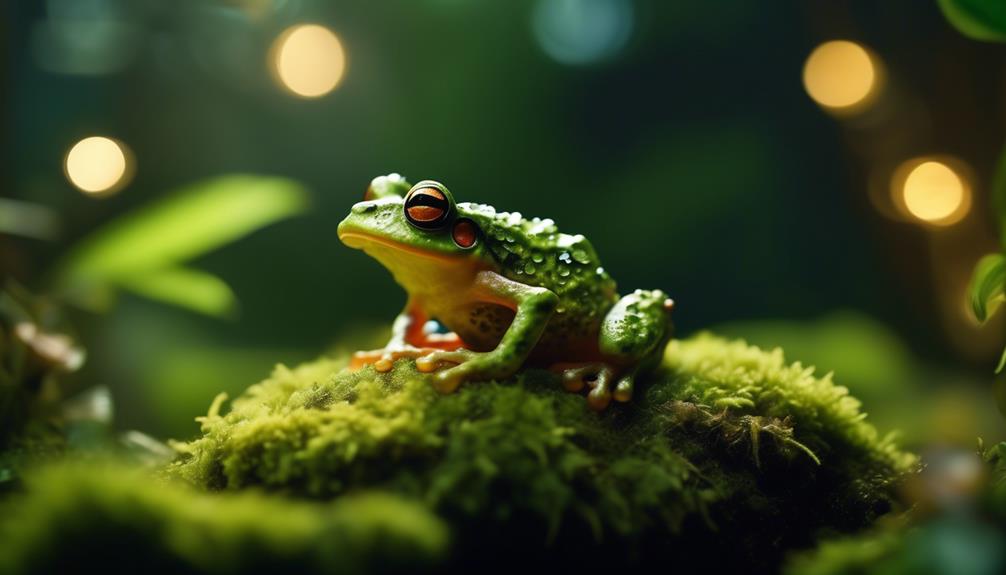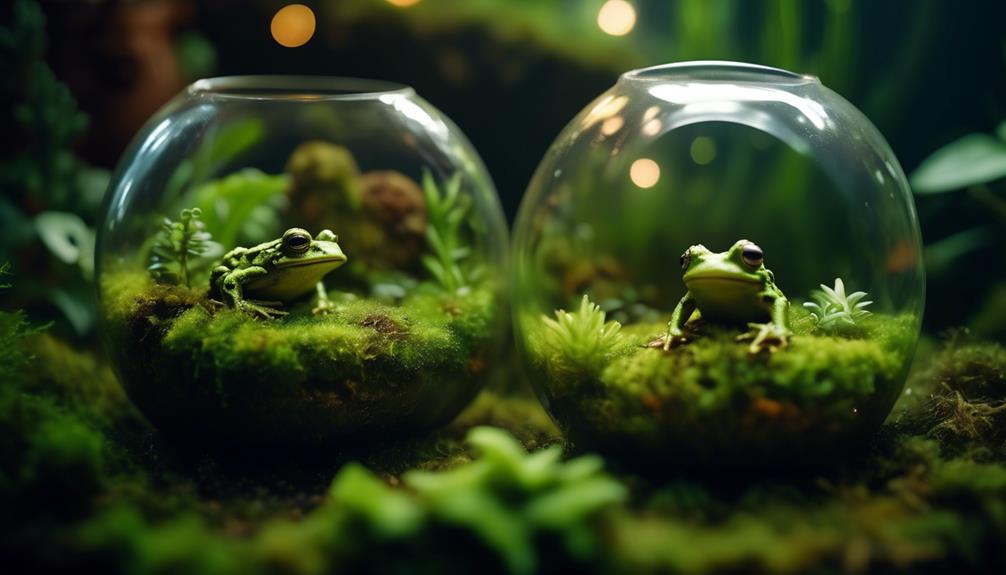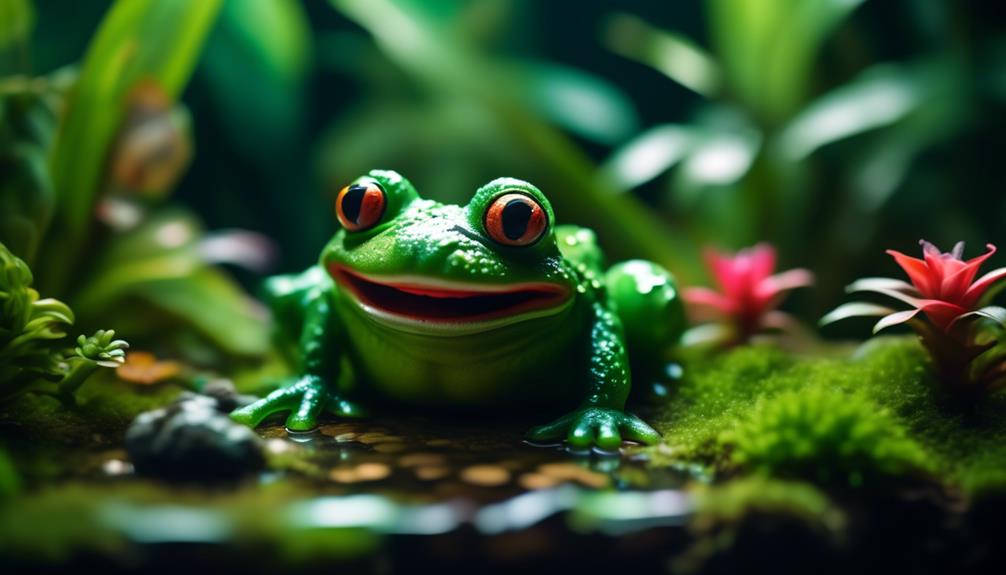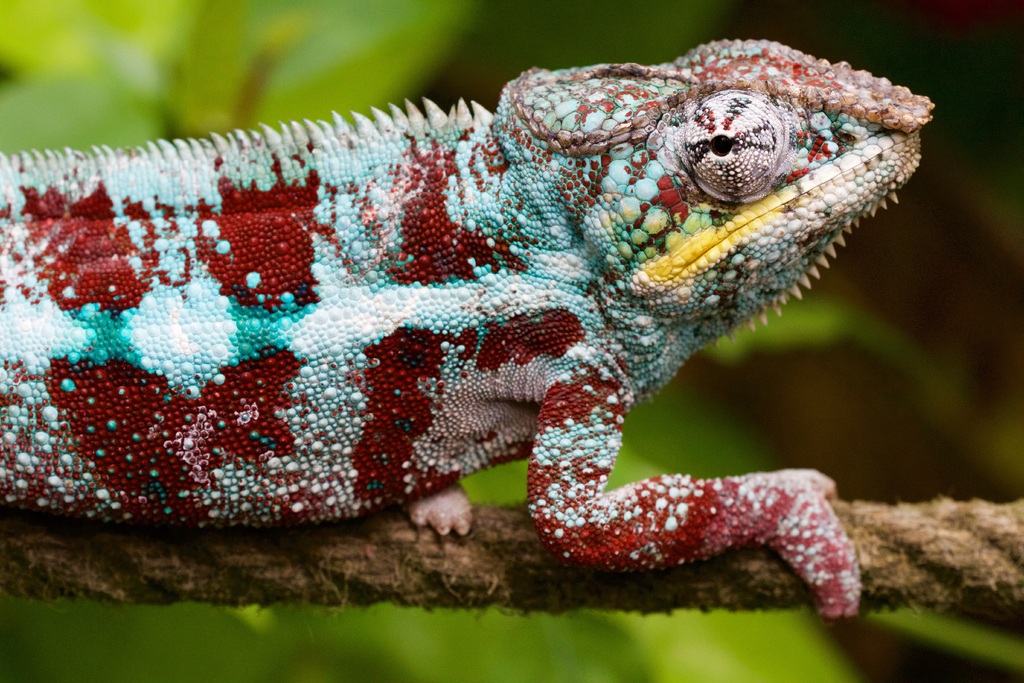Are you ready to embark on a journey into the captivating world of pixie frogs? Well, buckle up because we're about to unveil the secrets to ensuring your pixie frog thrives in captivity.
These astonishing creatures may appear docile, but they have specific requirements that must be met for them to truly flourish. From the ideal enclosure size that allows them to satisfy their natural curiosity to the crucial role of UVB lighting and basking temperatures in their growth and activity levels, there's so much to explore.
But that's not all – we'll also delve into the importance of humidity levels and substrate choices in creating a comfortable and thriving environment for your beloved frog.
So, let's dive in and uncover the key to unlocking the full potential of your pixie frog companion. Get ready to witness their incredible transformation!
Key Takeaways
- Pixie frogs require a minimum enclosure size of 40 gallons for adequate space and mobility.
- UVB lighting is essential for the frog's health, providing vitamin D and stimulating appetite and activity. Recommended UVB bulbs are Zoo Med T8 Reptisun 5.0 and Arcadia ShadeDweller.
- Basking temperatures should range between 75-90°F during the day, with a warm side around 90°F and a cool side around 75°F. Night temperatures can drop to 68°F.
- Maintaining a humidity level of around 60% is crucial for pixie frogs, achieved by providing access to standing water, a large water bowl, and using moisture-retentive substrates like peat moss or Eco Earth.
Enclosure Requirements

When it comes to providing suitable living conditions for thriving Pixie frogs, it's essential to meet their specific enclosure requirements. Building suitable habitats is crucial for their overall well-being.
Pixie frogs require a minimum enclosure size of 40 gallons or 36L x 18W x 18H, but larger enclosures are recommended to promote better mobility. Despite being sedentary creatures, Pixie frogs still need space to move around.
Proper ventilation is of utmost importance for their enclosure. It helps maintain optimal air quality and prevents the buildup of harmful gases. Adequate ventilation can be achieved by incorporating vents or mesh panels into the enclosure design.
This ensures a constant flow of fresh air for the frogs, promoting their respiratory health and overall thriving.
UVB Lighting
UVB lighting plays a crucial role in promoting the optimal health and well-being of Pixie frogs. These frogs require low levels of UVB lighting to receive the benefits it provides. UVB lighting helps in the production of vitamin D, which is essential for the absorption of calcium and healthy bone development. It also stimulates appetite and activity, ensuring a healthy metabolism.
When choosing the right UVB bulb for your Pixie frog, it's recommended to use bulbs such as the Zoo Med T8 Reptisun 5.0 or Arcadia ShadeDweller. These bulbs should be housed in a reflective fixture to maximize the amount of UVB the frog receives. It's important to note that the fixture shouldn't have a clear plastic bulb cover, as it can block the UVB rays.
Basking Temperatures

To ensure the optimal health and well-being of Pixie frogs, it's important to establish appropriate basking temperatures within their enclosure. Basking temperature regulation is crucial for these amphibians as it directly affects their metabolic rate, digestion, and overall activity levels.
Here are four key points to consider when it comes to basking temperatures for Pixie frogs:
- Temperature gradient: Providing a temperature gradient within the enclosure allows the frogs to thermoregulate effectively. The warm side of the enclosure should be maintained around 90°F, while the cool side should be around 75°F. This temperature variation allows the frogs to choose the area that best suits their needs.
- Daytime temperature range: Keeping the enclosure temperature between 75-90°F during the day is essential for Pixie frogs. This range mimics their natural habitat and ensures that they can bask comfortably to absorb heat and energy.
- Nighttime temperature drop: While Pixie frogs can tolerate lower temperatures, it's important to allow for a temperature drop during the night. Nighttime temperatures can safely drop to around 68°F, providing a natural cooling period for the frogs.
- Temperature monitoring: To accurately monitor the basking temperatures, it's recommended to use a digital probe thermometer. This will help ensure that the temperatures are within the appropriate range and allow for adjustments if needed.
Maintaining proper basking temperatures is vital for the health and well-being of Pixie frogs. By providing a temperature gradient, monitoring temperatures, and creating a suitable environment, you can help your Pixie frogs thrive.
Humidity Levels
Maintaining proper humidity levels is crucial for the health and well-being of Pixie frogs. These amphibians are dependent on water and require access to standing water and moist substrate. To prevent dehydration in pixie frogs, it is essential to maintain optimal humidity levels in their enclosure.
Here is a table outlining the recommended humidity levels and ways to maintain them:
| Humidity Levels | Recommendations |
|---|---|
| Average Humidity | Around 60% |
| Misting Frequency | 1-2 times daily |
| Water Bowl | Large and filled with amphibian-safe water treated with conditioner |
To maintain the desired humidity, misting the enclosure 1-2 times daily can help. Additionally, providing a large water bowl filled with treated water is important for the frog's hydration. The water used should be treated with an amphibian-safe water conditioner to ensure its safety. By following these guidelines, you can create an environment that prevents dehydration and promotes the well-being of your Pixie frog.
Substrate

Substrate selection is an important aspect of creating a suitable and healthy environment for Pixie frogs in their enclosure. Choosing the right substrate is crucial to maintain proper humidity levels and facilitate their natural digging behavior. Here are four key points to consider when selecting substrate for your Pixie frog enclosure:
- Moisture-retentive substrate: Pixie frogs require a substrate that can hold moisture well. Recommended options include peat moss, Zoo Med Eco Earth, Exo Terra Plantation Soil, Sphagnum moss, and Zoo Med Reptisoil. These substrates help maintain the necessary humidity levels for the frogs' well-being.
- Importance of substrate depth: It's essential to provide a substrate that's at least 4 inches deep. This depth allows Pixie frogs to engage in their natural digging behavior, which is important for their physical and mental stimulation.
- Hygiene maintenance: To ensure a clean and healthy environment, the substrate should be replaced on a monthly basis. This practice helps prevent the buildup of waste and bacteria, promoting the overall well-being of the frogs.
- Enhanced enclosure appearance: A thick layer of substrate not only serves practical purposes but also enhances the visual appeal of the enclosure. It creates a natural and aesthetically pleasing habitat for your Pixie frogs.
Frequently Asked Questions
What Is the Average Lifespan of a Pixie Frog?
The average lifespan of a pixie frog is around 10-15 years. Proper care involves providing a spacious enclosure, UVB lighting, basking temperatures of 75-90°F, humidity levels of 60%, and a moisture-retentive substrate.
Can Pixie Frogs Be Kept in Outdoor Enclosures?
Can pixie frogs be kept in outdoor enclosures? No, outdoor enclosures do not meet the specific habitat requirements of pixie frogs. They require controlled temperatures, humidity levels, and UVB lighting that cannot be consistently provided in outdoor environments.
How Often Should a Pixie Frog Be Fed?
We feed our pixie frogs every 2-3 days to ensure they receive proper nutrition. Their diet consists of a variety of insects, such as crickets, roaches, and mealworms. Providing a balanced and varied diet is crucial for their overall health and well-being.
Are Pixie Frogs Prone to Any Specific Health Issues or Diseases?
Pixie frogs are prone to common health issues such as obesity, skin infections, and respiratory infections. Preventing diseases in pixie frogs involves maintaining proper hygiene, providing a balanced diet, and regular veterinary check-ups.
Can Pixie Frogs Be Handled or Are They Strictly Display Pets?
Handling pixie frogs can stress them, so they are best kept as display pets. However, observing their unique behaviors and fascinating appearance can provide educational and aesthetic benefits.
Conclusion
In conclusion, creating a suitable habitat for your pixie frog is essential for their overall health and well-being. Providing them with ample space, proper UVB lighting, basking temperatures, and humidity levels is crucial.
Did you know that pixie frogs can live up to 15 years in captivity? With the right care and environment, these fascinating amphibians can thrive and bring joy to your life for many years to come.
So, take the time to understand their needs and unlock the secrets to unlocking the full potential of your pixie frog companion.

